Itaparica, Part I
Cruising notes given in good faith, but not to be taken as gospel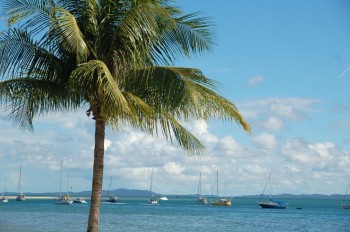
With a coastline 5,000 miles long reaching from the equator right down to the Tropic of Capricorn and beyond, Brazil ought to offer almost unrivalled opportunities for yotties – and so it does. Here, in this one country, we can sail past palm fringed beaches one month and pine covered mountains the next. We can swelter in temperatures of over 100°F (38°C) while friends, cruising further to the south, shiver on a frosty morning and wish they had fitted the boat with a heater.
We can also marvel at the variety of cultures to be encountered in this one domain: in the north of the country we can watch Afro-Amerindian fishermen casting nets from their dug-out canoes, and in the south we can enjoy the company of people with European ancestry and attitudes; people who own villas instead of adobe mud huts and who travel on the water purely for pleasure in fancy yachts and speed boats.
All this is available to us – if we can manage to scamper through the country within the six months permitted to visitors.
Doing justice to a 5,000 mile coastline in six months is… well, it’s impossible. However, to be honest this difficulty is not the one which causes most yotties to miss most of the sights and glimpse only one or two tiny portions of Brazil. The real problem is that we like to hang out with our friends.
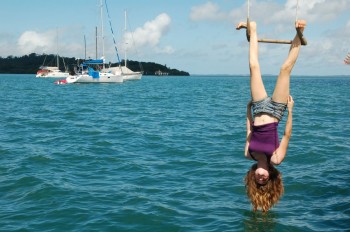
Solitude is fine – we love the peace and solitude of the ocean and we love to anchor all by ourselves in remote places – yet, somehow, once we have made friends we cruising yotties seem to sprout roots.
If our friends are hanging out in one particular place… well, that’s the place we will end up hanging out too. Once the ball is rolling it keeps on going – a very new arrival is a new friend! – and before you know it a nice-enough anchorage has become established as a focal point for the international cruising community.
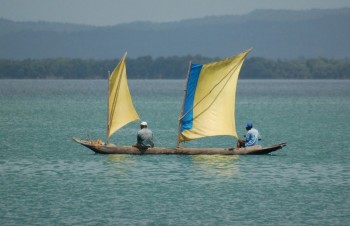
There are scores of interesting places on the coastline of Brazil but despite the variety of opportunities there are actually only two principal cruising grounds – one in the south, in the vicinity of Ilha Grande, and the other in the Bahia de Todos los Santos, overlooked by the city of Salvador.
Both of these regions offer a vast number of anchorages in a variety of locations, but in each case the focal point, for yotties, is a small town.
In the case of the Bahia, that town is Itaparica.
Itaparica – The Cruising Capital of the Bahia
Stay away from Salvador
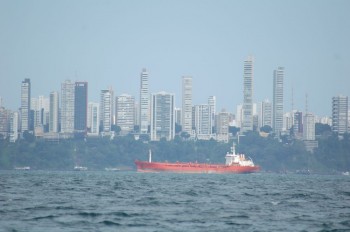
When speaking about the Bahia de Todos los Santos most of us tend to refer to the place as Salvador, but in fact, the majority of yotties spend as little time as they can in that cesspit. Salvador is the place that you have to go to do your paperwork (of which we will say more on another occasion), but after you have completed the legal formalities, you get out; hopefully, before you get mugged.
Every bad thing that you have ever heard about Salvador is pretty-much true. Oh, to be sure, it has some old buildings and a couple of monasteries. And it has a waterfront market which is stuffed full of tacky souvenirs. It has an interesting history. But it also has a ridiculously high crime rate, such that even our Salvadorian friends complain that they are scared to walk the streets, night or day.
However, after you have done your legal duty you need never go to Salvador again; and indeed, you need never take the boat there at all. If you don’t want to risk spending even one night in a dodgy marina you can bypass the wicked city altogether, sail directly to Itaparica, and then take the ferry back to the mainland to attend to the bureaucratic business .
The Solent with the heat turned up
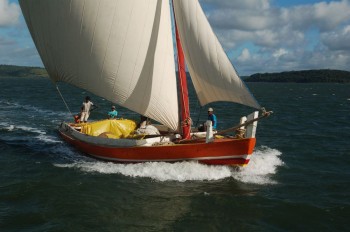
The Bahia would be a very different place were it not for Ilha Itaparica. The island lies slap-bang in the middle of the bay, blocking the waves. In the lee of the island the water is smooth even on a windy day, creating a splendid sailing playground. Some have compared the place to the Solent (England’s most famous and popular cruising ground) and one cannot deny that there are certain similarities. The rivers winding their way into the back of the bay could be said to resemble the Beaulieu River and Southampton Water; Fawley is represented by a similar but somewhat smaller oil refinery at Madre Deus. The sand bars which add interest to a day trip in the Bahia are certainly reminiscent of the Brambles, the Shingles, and Ryde Sands; and although it is low, Ilha Itaparica does much the same job as the Isle of Wight.
Yes, one can see the scope for a political twinning of Salvador and Southampton… but in reality the parallels are very superficial. Whereas the Solent is home to thousands of yachts, which mill about amongst an endless stream of ferries and hovercraft and big ships, the Bahia is a backwater. The big boys anchor in the mouth of the bay, off the wicked city, and pretty much the only commercial traffic to be seen in the basin are the “saveiros” – traditional gaff-rigged barges. As for pleasure craft: if you glimpse one other yacht while making your way from one anchorage to another – well, that counts as a busy day.
As it happens, Salvador boasts a thriving and very friendly yacht club, situated outside the town in the bay of Aratu, but like the visiting foreign yotties most of these sailors spend very little time exploring the bay; they prefer to pop across, at the weekend, to Itaparica.
Itaparica
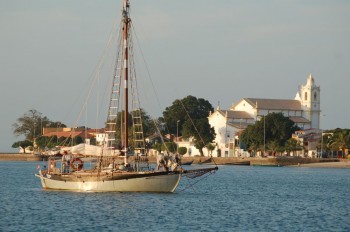
Perched on a thin strip of land twixt the cobalt sky and the Prussian blue sea, Itaparica is to the Bahia as Bosham is to Chichester Harbour: a quaint place with picturesque buildings and people pottering about in boats.
A huge white church dominates the skyline. A low but very elaborate fort clings to the tip of the island, nearby. Together, these two antique edifices seem to speak of a past which was glorious – or at any rate, wealthy – and the rows of colourful houses, with grotesque “icing” trimming their fronts, also supports this view. Until the 1980’s the main source of income was whaling – as, indeed, it was in many of Brazil’s small ports – but since international legislation forced the closure of this industry the humpbacks and other whales migrating along this coast have lived in safety, and the people of Itaparica have had to find another way to pay the bills. A few earn their crust by fishing, bait-digging, and beachcombing, but the main business nowadays is the up and coming one of catering to the needs of visitors.
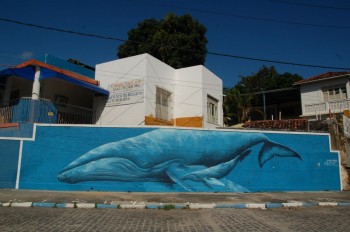
Ten years ago, they tell us, Itaparica was as sleepy as any place could be, but it is now making its way onto the tourist map. It is especially busy around Christmas time, when thousands of Brasilieros arrive to spend the festive season here.
Plans are afoot to build a huge bridge which will span the Bahia and tie the island to the city. At first glance this seems like a mad scheme. Spend millions of dollars on a five mile-long bridge, just for the sake of improving access to a rustic suburb…! “That will never happen!” we cried.
But, alas, it sounds as if it probably will. At the moment, traffic journeying up the coast of Brazil towards Salavdor has to make a 100 mile detour inland. Ilha Itaparica is already joined to the mainland at one end. Tying it in at the other will turn it into a useful stepping stone.
It will also turn the place into a suburb of the city – so, if you want to enjoy it, come soon!
Approaching Itaparica
DISCLAIMER – “not to be used for navigational purposes”
The following advice is given in good faith but must not be taken as gospel. Sand bars move, and so do buoys. The safety of a vessel is the responsibility of her skipper, and the author of this article cannot be held liable for any injury, death, loss, stranding, or other mishap which may result from following the suggestions given here. Amen.
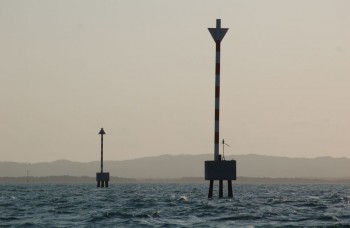
The village of Itaparica lies on the northern tip of the island, and the anchorage is situated just beyond the tip. The approach is a lot more straightforward than the clutter of navigation marks would seem to suggest. In fact, some of the buoyage is downright misleading.
For a start, you can ignore the pair of tall red and white striped beacons close to the point (Punta de Itaparica). These are actually part of a set of four pairs of beacons which are associated with a disused degaussing station.
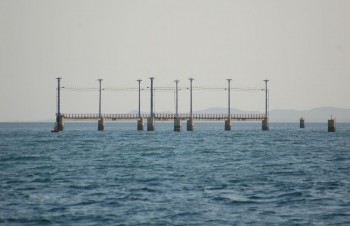
I always think that degaussing sounds like some sort of medical procedure – the extermination of an infestation of parasites, perhaps – but in fact it is the process of removing intrinsic magnetic fields from the fabric of a steel ship. These fields confuse the ship’s compass so that rather than pointing north it points at the bow or the stern.
Having spent some time inside the framework of posts and electric wires which stands just off Punta de Itaparica the patient is moved to a position at the exact centre of the four pairs of red and white striped beacons. When each pair is aligned like leading marks they lie precisely north, west, east, and south of a vessel stationed at their epicentre.
If they appear not to, then the cure has not been effective.
The more easterly of the eastern pair of compass-swinging beacons carries a green light, and if you are approaching by night you may as well do the proper thing and leave it to port (in accordance with the American buoyage system). By day, when the lie of the land is clearer, you can leave this pair of beacons close to starboard, if it suits you so to do, because the water there is just as deep.
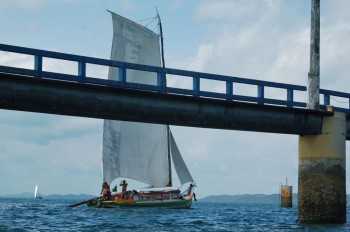
Although there are shallows extending from the shore on the east coast of the island, the water off the point itself is deep and you can pass as close as you dare to the spooky old degaussing framework.
Four dumpy concrete posts lead away from the framework on the northern side, and three similar ones extend in a south-westerly direction. Each post carries a fixed white light. There are no obstructions between them, and you do not need to go round the outside of the whole lot.
Having rounded the squat concrete posts, or dodged amongst them, you will come upon a westerly cardinal mark. This is intended to keep people off the shallows extending from this coast of the island, and you should heed its instruction and leave it to port. A suitable offing having been established, you can then head for the moored yachts.
DO keep an eye on the echo-sounder . We have seen a Beneteau sail itself so hard onto the shallows on the shoreward side of the channel that its bow was lifted out of the water.
DON’T go outside all of the yellow ‘special marks’. These buoys indicate the position of a pipeline which runs from the shore out to a small gas platform. (There are several of these mini platforms in the vicinity). Besides the yellow marks there is also a northerly cardinal lying about half a cable (100 yards) from the platform, but if you go along the line of yellow marks and around this buoy before turning into the anchorage then you will run straight onto a sand bar.
I mention this because we have seen someone do it.
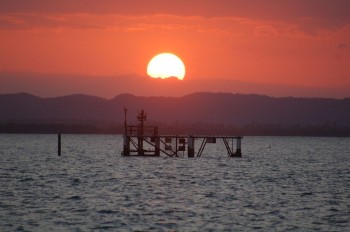
The northerly cardinal mark is associated with the channel running between Ilha Itaparica and the mainland shore. It has no relevance to vessels heading for the anchorage – but such vessels do need to know about the shoal which it marks.
At the time of writing (November 2012) the shallowest part of the shoal lies east of the gas platform, at 12°53.336’S, 38°41.323’W. The water here is less than knee deep at low water springs.
The shallow extends north towards the cardinal. (The aforementioned yotties, having misinterpreted the buoyage, spent a day with their vessel lying on her side in this vicinity.)
You may care to note that the Bahia is littered with shoals, or “coroas”. Most of them are marked, after a fashion, but visiting yachtsmen do seem to have a knack for finding them. Happily, since the bay is wonderfully sheltered there is never any sea running and, so far as I know, in each case the vessel has been floated off safely on the next tide.
In conclusion, the best course of action when approaching the Itaparica anchorage is to ignore most of the navigation marks and other clutter and to use common sense and the echo-sounder.
Head for the cluster of moored yachts; don’t try getting close inshore where the little boats are moored; don’t try going where the Ovnis have gone (unless you, too, have a centreboard); don’t go blundering on, beyond the general gathering, and hit the sand bar; and don’t decide to anchor well outside everyone else, “just to be on the safe side” – ‘cos that’s where the shoal is!
Approaching at night is almost as easy as by day, except that you have to keep a sharp look-out for those dratted ‘special marks’, which are unlit.
Time and tide wait for no man
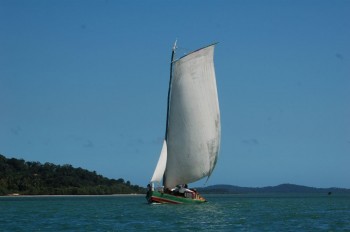
If you will be arriving under sail – and we hope that you will – then you may like to note that the flood tide flows southward down the Itaparica channel (between the island and the mainland, adjacent). So, if you’ve been slogging against the ebb as you pass along the east coast of the island, you’ll be slogging still for the last short stretch. Close by the point the current runs at up to 3 knots, so it’s worth paying attention to what’s going on.
The local sailing traders are masters of using the tide pragmatically and going with the flow, and after getting it wrong a couple of times the visitor learns to do likewise.
The anchorage
So far as we Mollymawks are concerned, the anchorage at Itaparica is safe and comfortable in all winds. Others, with smaller boats, disagree. In a strong southerly, when the waves are pushed up the Itaparica channel, some folks prefer to move further into the bay (to Salinas, for example).
The marina
Just beyond the anchorage there is a small floating marina, which is owned by the state. It is not the place to go in a southerly, because it, too, is subject to the swells which creep around the headland to the south. “Like being inside a washing machine” is how one friend described a rough night tied to the floating docks. We, meanwhile, had not even noticed that it was a windy night.
Other detractions in the marina include roaches, ants, and rats. A couple of friends have unwittingly picked up these stowaways during their stays here.
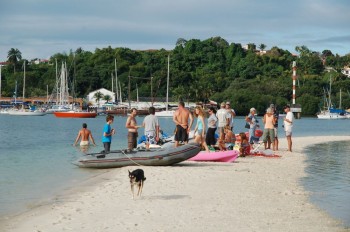
Most visitors go ashore through the marina, leaving their dinghies on the floating jetty near to the main pier. This jetty bears a notice stating that there is a charge of 5 Reis per day for mooring here – and if the security guard happens to be around when you show up, he will ask you to go to the office and pay.
Many people bluff their way around this, promising to pay and then not paying. Most pay on an occasional basis. One or two, fluent with the lingo, simply tell the guy to sod off – “You never ask the Brazilian yotties for money, so why are you hassling the visitors? You’re a racist pig!” etcetera.
Personally, we’re not happy with any of these approaches. We don’t own the jetty and it isn’t public property. We’re definitely not going to pay – for all sorts of reasons – but nor do we enjoy friction. Our philosophy is, if we’re not welcome then we’ll stay away.
We leave our dinghy tied to the steps some 100 yards to the left of the marina. This is not ideal – at low tide we sometimes have to paddle through a bit of mud; and at weekends the dinghy gets used, by the local kids, as a bathing platform – but we prefer this to the aggro involved in using the marina.
Crime
Best get this subject over and done with, since it is the one which weighs most heavily on the average visitor’s mind. Is it safe here?
Well… yes and no. By Brazilian standards it’s pretty safe; by European standards, it’s not.
The best thing for me to do, I think, is to recount, in brief those crimes which have taken place while we have been anchored here or which have concerned friends.
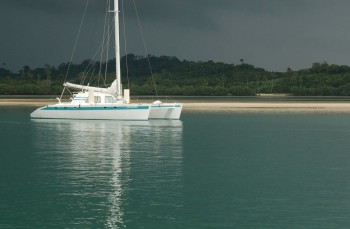
A German yachtsman, picnicking with his wife on a beach close to the anchorage, was shot at by “a fisherman”. According to the victim, the man arrived in another boat and tried to make off with his rubber dinghy. Our fellow ran after him – as one would, in the circumstances, I think. He was waving a machete.
The “fisherman” pulled out a gun and fired a shot which clipped the yachtsman’s head at eye level. (We saw the scar.)
This incident occurred on a pretty little, totally isolated beach on the far side of the coroa (sand bank).
Don’t go there.
A French couple – good friends of ours – were walking home along the seafront at a fairly late hour when they were mugged by two men armed with big sharp knives. The men demanded that the woman hand over her bag. After she had done so her husband tried to grab it back again…
The muggers slashed his arm and ran off. He received hospital treatment for his wounds.
If you’re going to dispute with a mugger, do it before you hand over the goodies; just tell him to naff off.
Better still, don’t dispute with a mugger. Be sensible; you’re in Brazil, where life is cheap and most crime goes unsolved. Don’t carry anything of value; don’t carry anything you would hate to lose.
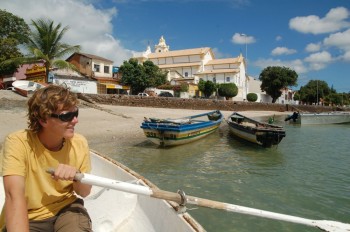
A German couple were mugged in broad daylight whilst walking in a rather isolated place (remote from any houses) on the far side of the town, adjacent to the beach. They handed over their bags, which contained swimming things and a bit of cash, and walked away somewhat shaken but otherwise unscathed.
These three incidents occurred over a period of about one year, and we received the stories first-hand, from the people concerned.
According to the cruising grapevine, a year before our visit a Frenchman was kidnapped while walking in the fisherman’s shanty town (where no sensible person would ever go) and was kept prisoner for a week while his bank account was slowly drained by use of his credit card.
I do not know whether this story is true.
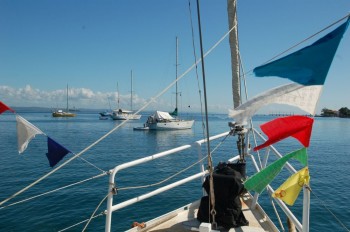
I also know of two boats which were boarded, while at anchor, by men wielding machetes. Their crews spent two hours tied up while the men ransacked the cabins.
Neither of these boats was moored in Itaparica. (One was anchored off the outermost marina in Salvador; the other was visiting the waterfall at the seaward end of the Itaparica channel.)
We have never heard of any yacht ever being boarded whilst moored off Itaparica.
Part II of this article describes the features and facilities which attract cruising yotties to Itaparica.
Update (04/01/2013)
A couple of people have suggested that I’ve been rather hard on Salvador. Surely I would have to agree that the monastery in Pelorinho worth a visit?
So – just for the record – the monastery is one of the most amazing examples of over-the-top Baroque art that I have ever seen. The outside is adorned from top to toe with extraordinarily lavish sculpting and reminded me somewhat of a wedding cake. Every inch of the ceilings within the chapel is likewise decorated with paintings of the saints. It is, indeed, an awesome spectacle – but personally I prefer the down-market side of Salvador.
My favourite quarter is not the nicely-kept tourist town of Pelourinho but the seedy area called Comercio. Specifically, the place I like best is the Feria Sao Joaquim – an open(ish)-air market immediately adjacent to the Salvador – Bom Despacho ferry terminal. The market is said to be the largest in Brazil. A large part of it consists of a warren of narrow, insalubrious alleys where one can buy fruit and veg, and all manner of other things, by the sack. This is not the place to wander alone, and I would not dream of taking my camera or any other valuables into the dark and complicated maze.
The most interesting part of the market is housed in a big warehouse at the eastern end of the complex and in the courtyard outside the building.
Entering through the gateway one slams into a wall of smell, the stench of chicken shit, fecund goat, salted pork, and putrefying fruit mingling with the scent of roasting corn-cobs. On our left is the animal market, and this is a very sorry sight. The kids, crowded into a holding pen, gaze in wonder at the passersby. The pigeons and doves attempt to strut but have scarcely enough room to stand in their chicken-wire cages. Worst of all are the chickens, ducks, and guinea-fowl, which lie where they were evidently tossed, on their backs in the hot sun. Their beaks are open; their staring eyes reveal their pain and distress. Every now and then one of them struggles to stand, but in vain; its feet are trussed together and it can no more stand than fly.
But you don’t have to witness this cruelty; instead, enter the warehouse. Here you will find stalls selling beans, stalls selling baskets, stalls selling earthenware pottery, and stalls selling aluminium pots, pans, and kitchen gadgets, but most ubiquitous of all are the stalls which sell everything you need to become a Candomble adept. And this is the thing that I like best about Salvador.
They’ve got everything in these Candomble shops. You can buy the ornate white dresses worn by the ladies, and the “lacy table-cloth” attire beloved of the men-folk. You can buy the coloured beads to make your own necklaces. You can buy even buy the crowns and ceremonial, jewelled (cardboard) axes used by the god of war and his initiates in the final stage of the pantomime.
You can buy drums (Candomble drums are much like Cuban congas in appearance), and you can buy calabash gourds from which to make your own maracas, but most evident of all are the brightly painted plastic statuettes which range in size from the length of your fore-finger to half your own height. These statuettes are representations of the various oreixa, or Candomble gods. You also can buy black, white, and red-painted wood carvings of a fierce spirit known as xxxxx. If you’re planning to anchor out in the sticks you could take one of these along; standing by the companion hatch, it just might serve to scare away any unwanted night visitors.
Some of the Candomble shops also sell medicinal herbs of various kinds, but one has no idea whether or not these are effective or even safe. My preference is for the “spells”, made from incense or chalk. You know where you are with a spell, hey! They come in a variety of flavours and packagings, but my favourite is the one which is labelled “Calls Money to You.” I also rather like the one called, “Men Will Come Crawling.”
Apparently you don’t have to believe in this stuff for it to work…
